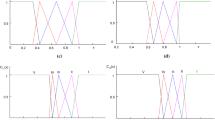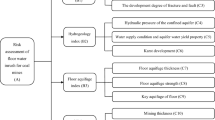Abstract
Taking account of the fuzzy results of the seepage monitoring analysis of roller compacted concrete (RCC) dam and uncertainties of the individual indicator evaluation, the fuzzy matter-element model of seepage monitoring of RCC dam analysis has been established with the use of the fuzzy matter-element analysis theory and the concept of euclid approach degree. The use of entropy theory can calculate the weighting factor through the disorder utility values of the information reflected by the data itself, which can effectively avoid the problems of weight distribution and uncertainties of subjective judgments of the seepage monitoring analysis of roller compacted concrete dam. And further the example shows that the analysis of entropy-based fuzzy matter-element analysis model of the seepage monitoring of roller compacted concrete dam is in accordance with the actual situation, which verifies the effectiveness of the method.
Similar content being viewed by others
References
Wu Zhongru. Safety Monitoring Theory and Its Application of Hydraulic Structures. Beijing: Higher Education Press, 2003 (in Chinese)
Wu Zhongru, Gu Chongshi. Hidden Trouble Detection and Health Diagnosis of Large Hydraulic Concrete Structure. Beijing: Higher Education Press, 2005 (in Chinese)
Gu Chongshi, Wu Zhongru. Safety Monitoring of Dams and Foundations-Theories & Methods and Their Application. Nanjing: Hohai University Press, 2006 (in Chinese)
Su Huaizhi, Wu Zhongru, Gu Chongshi. Mechanism of dam behavior assessment with fuzzy extension theory. Rock and Soil Mechanics, 2006, 27(11): 1967–1973 (in Chinese)
Su Huaizhi, Gu Chongshi, Wu Zhongru. Assessment model of dam behavior with fuzzy extension theory and its application. Rock and Soil Mechanics, 2006, 27(12): 2115–2121 (in Chinese)
Zhang Bing, Yong Qidong, Xiao Fangchun. Fuzzy Matter-Element Model. Beijing: Petroleum Industry Press, 1997 (in Chinese)
Cai Wen. Matter Element Model and Application. Beijing: Technology and Science Press, 1994 (in Chinese)
Zou Z H, Sun J N, Ren G P. Study and application on the entropy method for determination of weight of evaluating indicators in fuzzy synthetic evaluation for water quality assessment. Acta Scientiae Circumstantiae, 2005, 2(4): 552–556
Yan Wenzhou, Gu Liansheng. Application of the method of entropy proportion in the engineering mark. Journal of Xi’an University of Architecture & Technology (Natural Science Edition), 2004, 36(3): 98–100 (in Chinese)
Author information
Authors and Affiliations
Corresponding author
Rights and permissions
About this article
Cite this article
Gu, C., Zhang, Z., Cai, X. et al. Application of entropy-based fuzzy matter-element analysis in seepage monitoring of RCC dam. Front. Archit. Civ. Eng. China 5, 105–111 (2011). https://doi.org/10.1007/s11709-010-0015-4
Received:
Accepted:
Published:
Issue Date:
DOI: https://doi.org/10.1007/s11709-010-0015-4




